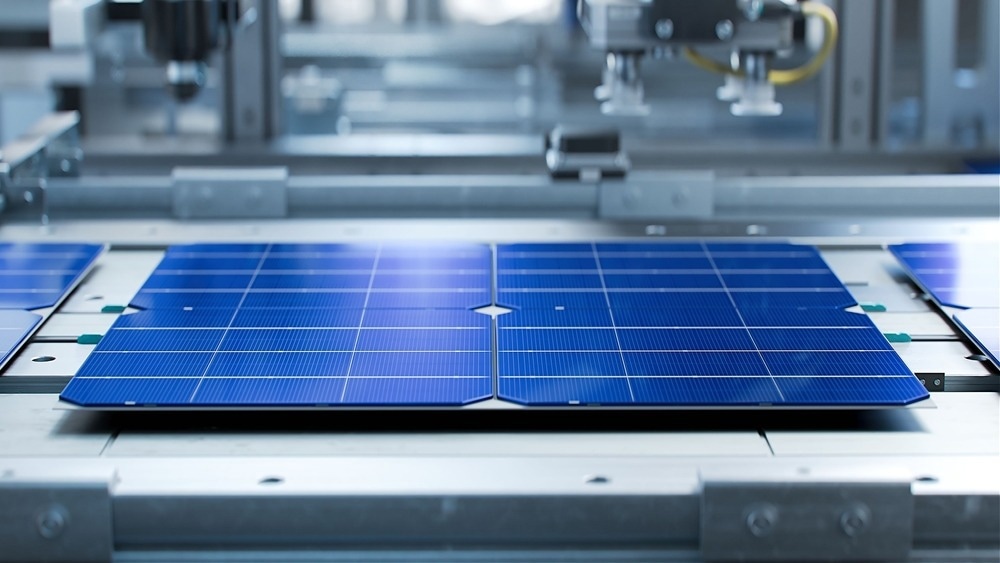A recent study published in the Chemical Engineering Journal presents a promising method for improving the performance and durability of flexible perovskite solar cells (f-PSCs) fabricated under ambient air conditions. Researchers applied stepwise interfacial engineering to tackle moisture-related challenges using low-dimensional phenethylammonium chloride (PEACl) passivation layers. This strategy aims to enhance device efficiency, humidity resistance, and mechanical resilience, offering a scalable, cost-effective path toward real-world applications.

Image Credit: IM Imagery/Shutterstock.com
Challenges in Perovskite Solar Cell Technology
Perovskite solar cells (PSCs) are a leading contender in next-generation photovoltaic (PV) technologies, known for their high power conversion efficiencies and potential for low-cost production. However, achieving high performance typically requires fabrication in inert environments to prevent moisture-induced degradation. This limitation raises manufacturing costs and hinders large-scale deployment.
Flexible PSCs are particularly sensitive to moisture, which can cause the perovskite material to degrade and generate defects. They are also more susceptible to mechanical stresses such as bending and sliding, often resulting in fractures and delamination. Addressing these vulnerabilities—especially under ambient air conditions—is critical for making flexible PSCs viable in commercial settings.
Study Overview: A Dual-Sided Passivation Strategy
The research team developed a dual-sided, two-dimensional (2D) passivation method using PEACl, applied to both the bottom and top interfaces of the perovskite absorber layer in inverted (p-i-n) PSC architectures.
To treat the bottom interface, PEACl was blended with the hole transport layer (HTL) material 2-(3,6-dimethoxy-9H-carbazol-9-yl)ethyl phosphonic acid (MeO-2PACz), preventing dissolution during perovskite deposition. After forming the perovskite film, the top interface received a separate PEACl treatment.
Characterization techniques such as Raman spectroscopy and X-ray photoelectron spectroscopy (XPS) confirmed strong chemical interactions between PEACl and MeO-2PACz, leading to reduced surface energy. Atomic force microscopy (AFM) revealed a smoother HTL surface, which supports better contact with the perovskite layer and more efficient charge extraction.
High-resolution transmission electron microscopy (HR-TEM) showed lattice spacings consistent with 2D perovskite phases at both interfaces, confirming successful passivation. Photoluminescence (PL) spectroscopy indicated stronger emission signals and clear 2D perovskite peaks, suggesting reduced defect density and higher film quality. X-ray diffraction (XRD) analysis further supported these findings, showing suppression of unwanted lead(II) iodide (PbI₂) phases due to effective defect mitigation.
Improved Efficiency and Stability Under Real-World Conditions
Using the dual-sided 2D PEACl passivation strategy, the team fabricated PSCs in ambient air with relative humidity (RH) ranging from 10% to 60%. The optimized devices reached power conversion efficiencies (PCEs) of 20.41% for rigid and 19.20% for flexible PSCs—significantly higher than non-passivated control devices. The flexible-to-rigid PCE ratio hit 94.07%, indicating minimal performance trade-offs.
The passivated devices remained stable up to 50% RH, demonstrating strong humidity resistance. Beyond this level, performance dropped due to irreversible perovskite degradation and increased PbI₂ formation. Larger-area devices (1 cm²) fabricated in ambient air also showed promising performance, achieving a 17.61% PCE with passivation.
Mechanical durability was another standout. Flexible PSCs retained 96% of their initial efficiency after 10,000 bending cycles (5 mm radius) and 87% after 10,000 shear-sliding cycles, outperforming their unpassivated counterparts.
Under air storage conditions (30 ± 5% RH), passivated cells maintained 85% of their initial PCE after 2,800 hours, compared to only 40% for controls. They also showed improved thermal stability, retaining 80% of initial efficiency after 1,056 hours at 85 °C.
What This Means for Flexible Solar Technology
This dual-sided 2D passivation technique addresses key barriers to fabricating high-performance flexible PSCs under ambient conditions, specifically moisture vulnerability and mechanical fragility. By reinforcing interfacial bonding and reducing defects, the method enables the production of devices that perform comparably to those made in controlled environments, while being more robust and scalable.
The ability to manufacture efficient, flexible PSCs in ambient air without sacrificing performance is a significant step toward commercial viability. It opens the door to lightweight, portable solar technologies that are easier, cheaper to produce at scale, and well-suited for real-world energy applications across varied environments.
Conclusion and Future Outlook
This study shows that stepwise interfacial engineering using PEACl passivation significantly improves the efficiency, moisture tolerance, and mechanical stability of flexible PSCs fabricated in ambient air with up to 50% RH.
The minimal efficiency gap between rigid and flexible formats, along with the improved film quality, underscores this technique's promise for practical solar solutions.
Future research should explore optimized passivation chemistries, improved encapsulation strategies, and methods to extend humidity tolerance beyond 50%. Scaling up production while maintaining long-term operational stability will also be key.
Disclaimer: The views expressed here are those of the author expressed in their private capacity and do not necessarily represent the views of AZoM.com Limited T/A AZoNetwork the owner and operator of this website. This disclaimer forms part of the Terms and conditions of use of this website.
Source:
Albab, M, F., & et al. (2025). Air-processed flexible perovskite solar cells with superior mechanical reliability and humidity resistance enabled by stepwise interfacial engineering. Chemical Engineering Journal, 164371 (518). DOI: 10.1016/j.cej.2025.164371, https://www.sciencedirect.com/science/article/pii/S1385894725052064?via%3Dihub